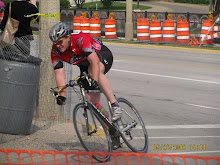I have just started racing bikes competitively this year. I was very intimidated by the idea of Criterium Racing, which is essentially grand prix type of racing. There is an approximately 1-mile loop with four 90-degree corners and speeds average about 25 mph, with sprints in the mid-upper 30s. I have upgraded from Category 5 to Category 4 in about 2 months time.
I joined up with a team, and have begun riding and training with guys that have serious racing chops. The best part about this is that I have a better perspective on group riding. To begin with, a novice racer competes in a Category 5 or Citizen race class. After racing a certain number of times and competing well, you can upgrade to the next category.
My new perspective applies to group rides, with guys that qualify as a weekend warrior. These are the Category 6 riders. Cat 6 riders are the guys that hold a loose line, standup on their bike without announcing it, sit-in in the draft, and generally like to go fast. These go-fast riders haven't developed core cycling form and etiquitte. Several things are necessary to ride well in and amongst other riders because at speeds of 25 mph you become responsible for others' safety. Rear wheels are stable, front wheels are not...A front tire colliding with a rear tire is often a recipe for a wreck...this is why you are reponsible for those behind you. Below are select items of importance:
1) HIGH CADENCE - A smooth, high cadence (85-100 RPM) will allow you to keep a straight line without too much lateral motion of the bike. This will also allow the rider to match accelerations of the group.
2)BRAKES - Stay clear of the brakes. It is more important to learn how to control your bike speed using wind resistance. Sitting taller on the bike will get the wind to slow your speed, or drifting slightly off of a draft will do the same. This allows for fine-tune adjustment of your speed. Hitting the brakes results in rapid speed loss that is amplified through the remaining followers in the group. This can be dangerours, and put riders into road hazards that the pace setters of the group were able to avoid. Unless you are avoiding a severe hazard, or coming to a complete stop, it is best to feather your front brake if you use your brakes at all. A following rider that sees your rear brake move may take evasive action (as they should, if they are riding with an otherwise experienced group)
3)STANDING?? SHOUT IT OUT - Announce if you are going to stand on a climb. When you stand on a bike, the bike move back approximately 1-2 feet compared to the rider that did not stand. Typical follow distances may be as close as 2" and typically 6"-1'. The following rider is likely to collide with the standing rider and lose control.
4)YOU DON'T HAVE TO PULL - This is my own peeve...If you can only go a certain speed in the draft, and you are unable to create that same speed on your own without the draft for at least several minutes, you create a hazard. The hazard is not imminent, but will manifest when the pace line encounters a hill. When the grade overcomes the wind resistance, the weaker rider will not be able to hang onto the pace, over-exert, crack/become dead weight/drop-anchor, and create an obstacle for the others. If you can only hang in the draft, then stay in the back of the group, and periodically try to get into the wind to feel what kind of effort the pace setters are putting out. Do this enough, and you will be able to take your pulls in front of the group after improving your conditioning.
I call this Category 6 because people would often talk about how dangerous Category 5 bike races can be. I have found that the group rides are more dangerous than the Cat 5 races, and therefore deserve their own designation.
Subscribe to:
Post Comments (Atom)

No comments:
Post a Comment